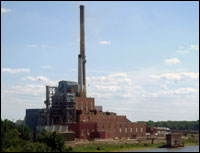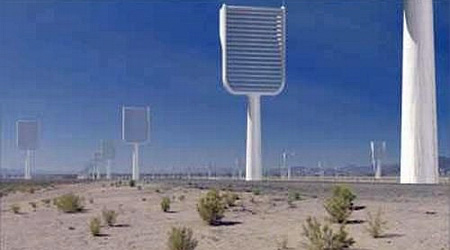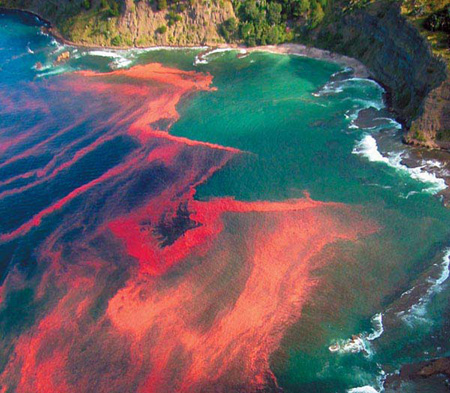Lesson 11 - Geoengineering
The links below provide an outline of the material for this lesson. Be sure to carefully read through the entire lesson before returning to Canvas to submit your assignments.
Introduction
About Lesson 11
We have seen that adaptation is one of the means of dealing with climate change impacts. Indeed, we will have to adapt to some changes that are in store. However, adaptation alone is unlikely to represent an adequate response to the challenges posed by climate change. That leaves only mitigation of climate change itself as an alternative. Fundamentally, there are two different forms of mitigation that have been widely considered —reduction of carbon emissions and geoengineering. Geoengineering attempts to offset the climate changes themselves through other means of human intervention in the climate system. In this lesson, we will look in more detail at the various geoengineering schemes under consideration.
Video: The Home Stretch - part 1 (1:35)
The NCAA tournament, which currently just went beyond the sweet 16 into the Elite Eight shows we're in the home stretch of the NCAA tournament. We're also in the home stretch of this course. It's the latter half of the second half. We've talked about the basic science behind climate and climate change. We've talked about the model projections under various possible scenarios of future carbon emissions, and we've talked about the potential impacts of those emissions, so now we're going to talk about the issue of what to do about this problem. We will consider a few different possibilities. Right now, we've started talking about adaptation, what adaptive measures can we take to adapt to the changes that are coming and in fact we are already committed to some amount of future climate change no matter what we do with our emissions so some degree of adaptation will be necessary. And so we've been talking about adaptive measures we can make in the area of water supply agriculture dealing with sea level rise and other impacts of climate change, but beyond adaptation what can we do to deal with the problem of climate change?
Video: The Home Stretch - part 2 (2:24)
What can we do to deal with the problem of climate change? Well, we can try to mitigate it, and there are actually two different approaches that have been widely discussed in recent years. One of them that's quite controversial is so-called geoengineering, so one possibility is we try to engineer our way out of climate change by perturbing the climate system in other ways to offset the warming due to increasing greenhouse gas concentrations. So we'll talk about that concept of geoengineering and what it might be able to accomplish and what the potential pitfalls are. Finally, if we don't consider geoengineering as a viable solution to the problem, that leaves us with only one solution to stemming the problem at its source which is the increasing greenhouse gas concentrations themselves, and so our final lesson of the course will be talking about mitigating greenhouse emissions. Carbon emissions cross every sector of society, every sector of modern civilization from energy supplied at transportation, to agriculture, to buildings, construction of buildings, to waste management. So clearly if we're going to decrease carbon emissions we need to consider potential actions across all sectors of our modern economy and modern civilization, and so we'll talk about those details, and we'll see if it indeed is possible to decrease emissions in a way that is consistent with stabilizing greenhouse gas concentrations at a level below that where we will start to see some of the more dangerous impacts that we've talked about in this course. And so it isn't coincidental that the titlist course is from meteorology to mitigation. We started with the basic science, the basic meteorology and atmospheric science of climate change, and now as we finish up the course we're going to take the problem all the way through the issue of solutions, or what we do about the problem.
What will we learn in Lesson 11?
By the end of Lesson 11, you should be able to:
- Summarize the geoengineering schemes that have been considered in the context of climate change mitigation; and
- Evaluate the relative strengths and weaknesses of different geoengineering schemes
What will be due for Lesson 11?
Please refer to the Syllabus for specific time frames and due dates.
The following is an overview of the required activities for Lesson 11. Detailed directions and submission instructions are located within this lesson.
- Project #2 due.
- Begin Project #3: Suppose you had 3 minutes to talk to your local congressperson about climate change. What would you tell him/her? Record a 2-3 min video, which will be available to the class to discuss and critique.
- Participate in Lesson 11 discussion forum: Geoengineering.
- Read:
- Dire Predictions, p. 192-193
- Keith 2001, Crutzen 2006, and Robock 2008. (Registered students can access the readings in the Lesson 11 module in Canvas.)
Questions?
If you have any questions, please post them to our Questions? discussion forum (not e-mail), located under the Home tab in Canvas. The instructor will check that discussion forum daily to respond. Also, please feel free to post your own responses if you can help with any of the posted questions.
What is Geoengineering?
Geoengineering is the intentional manipulation of our environment at the global scale. Anthropogenic impacts on our climate thus far do not qualify as geoengineering, because their intent was not to change our climate —climate change was an unintended consequence of the burning of fossil fuels (and the production of sulfate aerosol and, to a lesser extent, changes in land surface properties resulting from human actions).
Geoengineering, at this point, is still only a theoretical construct. But it is increasingly discussed as one of the possible means of mitigating climate change. The idea, at least in principle, is rather simple. It involves engaging in planetary-scale manipulation of the Earth in such a way as to offset the warming impacts of increasing greenhouse gas concentrations.
A variety of geoengineering schemes have been proposed, or at least envisioned. Some involve relatively minimal manipulation or tampering with the environment. For example, carbon capture and sequestration (CCS) involves capturing CO2 from emissions before they enter the atmosphere; while air capture amounts, in essence, to trying to "put the genie back in the bottle", i.e., to actively take carbon out of the atmosphere through, e.g., reforestation or building the equivalent of artificial trees that suck carbon out of the atmosphere more efficiently than natural trees. In all of these cases, the captured carbon must be buried underground or in the deep ocean, where it is isolated from the atmosphere, at least for some time. Other ideas involve fertilizing the ocean by adding iron, which is a limiting nutrient for marine phytoplankton in otherwise very highly productive regions of the oceans, such as the North Atlantic. In principle, this would enhance biological productivity and, therefore, lead to increased uptake of atmospheric CO2 by the upper ocean.
Other schemes attempt to offset the surface warming influence of greenhouse gas increases by reducing the amount of solar radiation impinging on the Earth's surface— so-called solar radiation management. One such scheme involves mimicking the cooling effect of volcanic eruptions by shooting sulfate aerosols into the stratosphere (see, e.g., this review at the site RealClimate [1]). Another scheme involves placing large numbers of reflecting mirrors in space at a stable position in the Earth's orbit. Related schemes involve increasing the Earth's surface albedo by various means (a possibility we also investigated in Problem Set #3).
We will discuss various of the proposed schemes and their relative advantages and disadvantages in more detail over the course of this lesson.
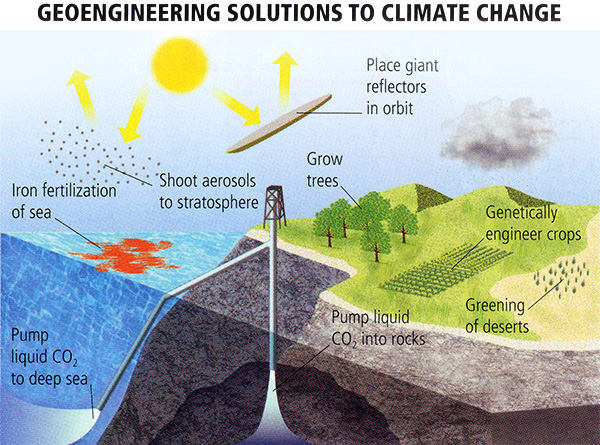
© 2015 Pearson Education, Inc.
Carbon Capture and Sequestration
Arguably the safest of the proposed geoengineering schemes, i.e., the one that is least invasive with respect to the Earth system, is carbon capture and sequestration (CCS). The main idea in this case is to prevent the carbon released during fossil fuel burning from ever getting into the atmosphere. In principle, this would allow for energy generation from fossil fuels with near zero carbon emissions. CCS is only economical when it can be applied to large point sources. In the context of energy generation, this applies almost exclusively to coal-fired power plants. CCS can also be used, however, to capture and sequester carbon emissions resulting from industrial processes, such as steel and cement manufacturing, petroleum refining, and paper mills.
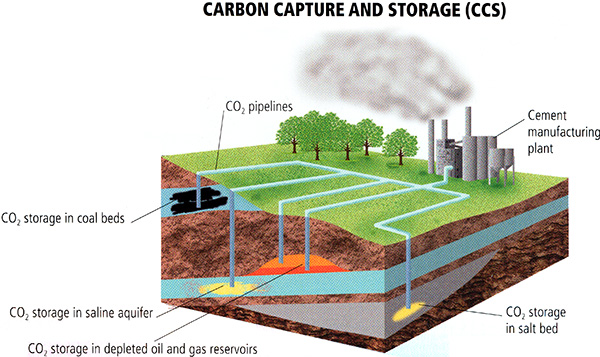
© 2015 Pearson Education, Inc.
While CCS has been implemented in various forms, the first full scale "proof of concept" for CCS in the context of coal-fired power generation was known as FutureGen, and was implemented in Illinois. Once operating, FutureGen would allow for the collection of data regarding efficiency, residual emissions, etc., and form a basis for evaluating performance that would be vital if and when CCS were to be deployed commercially at a larger scale in the future. The project was funded by an alliance of the Department of Energy and coal producers, users, and distributors.
CO2 released during electricity generation from coal burning is scrubbed from the emissions and captured, compressed and liquefied, and then pumped deep into the Earth (several km beneath the surface) where it is reacted with porous igneous rocks to form limestone. This approach mimics the geological processes that bury CO2 on geological timescales, and provides a potential means for long-term geological sequestration of CO2.
CO2 is captured through a process known as oxy-combustion. This process burns coal in a pure mixture of O2 and CO2 (by first removing N2 from the air), which results in relatively pure mixture of CO2 after combustion, from which any residual pollutants (e.g., sulfate, nitrate, etc.) can be removed. The relatively pure remaining CO2 is then compressed and liquefied, and the liquid CO2 can readily be transported deep below for storage. FutureGen scientists estimate that they can annually bury roughly 1.3 million tons of CO2 (i.e., 0.0013 Gigatons carbon per year), equivalent to roughly 90% of the carbon emitted by the plant's coal burning.
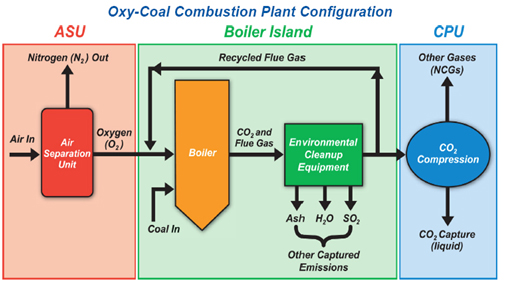
Why was FutureGen considered a good choice for testing the efficacy of this CCS? The geology of the Mount Simon site in Illinois is well suited for CCS, but it is also reasonably representative of geological formations found in many other regions of the world, so that whatever is learned from FutureGen could, in principle, be applied to many other potential CCS sites around the U.S. and the world.
Geological formations that contain salt water, like Mount Simon, are ideal because of their porosity. Moreover, there is impermeable caprock to seal in CO2. The formation is deep, placing it well below the depth of aquifers that are tapped for fresh water supply.
More than anything else, FutureGen was proposed as an experiment. The FutureGen operation would have evaluated potential storage sites before deciding precisely where the liquefied CO2 would have been injected for long-term storage, based on both theoretical modeling and data collection to evaluate detailed geological information about potential storage sites. The effectiveness of the injection system would be evaluated, and there would be continual monitoring of the burial process to ensure that CO2 is indeed being sequestered and remains sequestered. Whatever is learned could, in principle, be applied to any full-scale future deployment of CCS in the U.S. and abroad.
Unfortunately, due to difficulties of committing public funds and acquiring public funds, the FutureGen project, reconstituted as the FutureGen 2.0 project, was finally suspended in February 2015 (read the article here [3]). The Kemper County pre-combustion CCS plant in Mississippi came in $4 billion over budget and finally switched to natural gas combustion without any CCS [4]. However, other CCS projects have started or should begin in the near future, such as the large post-combustion coal-based Petra Nova [5] project in Texas, and the sequestration of CO2 [6] from ethanol production into the Mount Simon formation. Other CCS projects are working with non-coal based power plants, like the CarbFix program in Iceland [7].
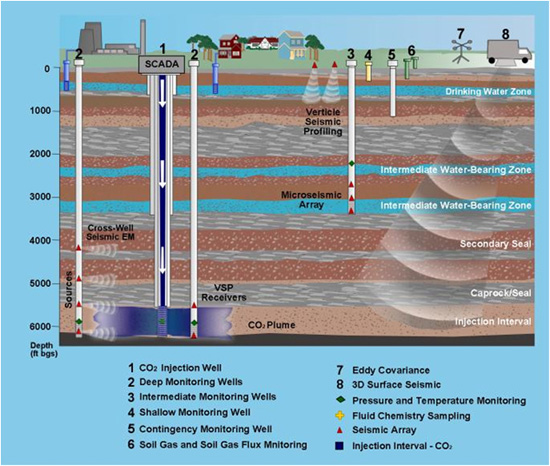
CCS might sound like a fool-proof plan for mitigating greenhouse emissions, but many of the assumptions made above may be over-optimistic. Even if the 90% rate of sequestration were correct, that would mean that 10% of the CO2 would still escape to the atmosphere, i.e., even in the best of scenarios, CCS-equipped coal-fired power plants would continue to emit CO2 into the atmosphere, just less of it. Moreover, in the event of unforeseen events, such as earthquakes, or other seismic activity, or alterations in groundwater flow, the efficacy of CCS in any particular location could be compromised. That would mean that the great initial investment made to establish the CCS site would be wasted, and the economic viability of CCS vs. other schemes to lower the carbon intensity of energy production might be undermined.
Despite all of the talk these days about "clean coal technology," such technology — in the sense that "clean" is taken to mean energy that is free or nearly free of polluting greenhouse gases — does not yet exist and remains hypothetical. Until data from experimental sites such as FutureGen have been collected and studied for some years, it will be unclear how much CO2 is actually being sequestered, and it would literally take decades until the efficacy of true long-term carbon burial could be established. Yet, we have seen that even a decade or so of additional business-as-usual greenhouse gas emissions could commit us to substantial and potentially detrimental future climate change. So CCS, despite the promise that it shows, may not be the "magic bullet" we are looking for.
Air Capture
The concept of air capture involves, in essence, "putting the genie back in the bottle". Unlike CCS, which targets emissions from major point sources before they escape into the atmosphere, the CO2 has already made it into the atmosphere in this case, and the objective is to scrub it back out of the ambient atmosphere. One simple way to do this is to grow more trees. Just as deforestation adds CO2 to the atmosphere, reforestation can, in principle, take CO2 out of the atmosphere. Of course, things are not always as easy as they seem. When the trees die, much of the carbon makes it back into the atmosphere as the organic material decomposes, and so the carbon burial process is incomplete and inefficient. There are other problems with this approach. As climate scientist Ken Caldeira of Stanford's Carnegie Institution has pointed out (e.g., in this op-ed [8]in the New York Times), growing more trees in extratropical seasonally snow-covered regions could have the unintended consequence of actually warming the climate by decreasing the Earth's winter and early spring albedo.
Well, what about artificial trees? In fact, this idea has been taken quite seriously in recent years. Synthetic "super trees" might be designed in a way that allows them to take up CO2 far more efficiently than actual trees. They would be immortal in the sense that they would not die, decompose, and return carbon to the atmosphere. And they can be constructed to be white and reflective, not only avoiding the tree albedo problem referred to above, but potentially even increasing the Earth's albedo. More efficient than actual trees, networks of these artificial trees deployed around the world could potentially sequester a non-trivial fraction of the carbon emitted by fossil fuel burning.
In the artificial tree scheme, CO2 is captured from the air using a chemical filter, then removed from the filter for permanent burial. Calcium oxide (also known as "Quick lime"), for example, will absorb CO2 from a mixture of air and steam at high temperatures (400°C or so) to form calcium carbonate, and will then release the CO2 at even higher temperatures (1000°C or so), making it a convenient means for both capturing the CO2 and then releasing for compression and burial. The heating, of course, requires an input of energy, but that can be provided by concentrated solar heating so that no input of fossil fuel-generated energy is necessary.
A potentially more efficient scheme has been introduced by Klaus Lackner of Columbia University. In Lackner's scheme, the "artificial tree" towers are designed to capture CO2 through the use of chemical reactions based on ion exchange resin, where the capture and release of CO2 can be accomplished by varying humidity rather than temperature, which greatly reduces the required input of energy.
These schemes might seem rather fanciful and far-fetched, but, in fact, they are quite implementable. Using a relatively rudimentary carbon capture tower back in 2008 as a proof of concept, geoengineering researcher David Keith at the University of Calgary demonstrated that half of the CO2 could be removed from the air entering the tower. The issue is not the feasibility of the technology, but rather the cost-effectiveness of the technology. After all, the approach will not be viable as long as cheaper approaches are available. This problem becomes particularly clear when one compares with, e.g., conventional CCS [10] as discussed in the previous section, which takes advantage of the far greater efficiency of capturing carbon from concentrated streams of CO2 compared with more diffuse ambient levels in the atmosphere.
However, if the cost of emitting carbon becomes large enough, or put differently if the value of capturing carbon from the atmosphere becomes great enough, then this technology may indeed become cost-effective. For example, in the event that the climate change is perceived as nearing a dangerous threshold and the importance of imminent stabilization of CO2 levels grows ever greater, air capture offers the only means of achieving relatively rapid stabilization of CO2 levels. Indeed, air capture is the only means by which we might actively lower atmospheric CO2 levels if we conclude that even current levels (i.e,. roughly 400 ppm) are too high. NASA/GISS Director James Hansen, for example, has argued that even sustained atmospheric concentrations of 350 ppm will eventually lead to dangerous climate changes such as the melting of the major ice sheets. Hansen's arguments have led to a popular climate change movement known as 350.org [11] which indeed is aimed at achieving 350 ppm stabilization.
One might, of course, argue that other geoengineering approaches, such as solar radiation management (which we will investigate in the next section of this lesson [12]) could accomplish this goal. However, as we shall see, one critical flaw in schemes that try to offset greenhouse warming with cooling techniques from, e.g., sulfate aerosols, is that this does nothing to halt the buildup of CO2 in the atmosphere and, as we have seen earlier in this course [13], the buildup has other serious consequences, such as ocean acidification.
Solar Radiation Management
Perhaps the most widely discussed and the most controversial of geoengineering schemes involves solar radiation management. Rather than reducing greenhouse gas concentrations, as in the other schemes we have looked at so far (CCS and Air Capture), this geoengineering approach instead seeks to offset the warming effect of increasing greenhouse gas concentrations by reducing short wave radiation received at the Earth's surface. There are a number of ways to do that. Some involve decreasing the amount of solar radiation reaching the surface—this might be thought of as effectively modifying the value of the solar constant, while others involve increasing the surface albedo.
One could consider the introduction of sulfate aerosols into the lower troposphere, which as we know has offset some of the greenhouse warming over the past half century, as such a form of geoengineering. However, since geoengineering, strictly speaking, involves the intentional manipulation of the Earth System, we tend to consider this as an unintended human impact on the climate, much as greenhouse warming, or deforestation, or many other changes in land surface properties due to human influences, are unintentional human impacts.
Nonetheless, these unintended human influences on the climate provide some insight into how intentional forms of manipulation of the short wave radiative forcing of the Earth's surface might potentially be used to offset greenhouse surface warming. For example, we could choose to remove sulfur scrubbers from smokestacks or, in the case of emerging coal users such as China, intentionally not install these scrubbers. We have already seen that the current sulfate aerosol burden is equivalent to us not having emitted a certain amount of CO2. In other words, measured in terms of CO2 concentrations, the mean cooling effect of tropospheric sulfate emissions can be thought of as a sort of a "free pass" for some share of the CO2 concentration increase we have seen so far.
Think About It!
Do you happen to remember how the mean cooling effect of tropospheric sulfate aerosols can be expressed in terms of CO2 concentrations? This is equivalent to all of the CO2 emitted since what year?
Click for answer.
And given current levels of ~410 ppm, that's equivalent to all of the CO2 that has been emitted in the last 30 years!
So, as far as global mean temperatures are concerned, maintaining the current sulfate aerosol burden has the equivalent offset influence on global mean temperature as the increase in CO2 levels seen over the past thirty years. Yet, there are reasons why this sulfate aerosol production is undesirable: acid rain, for example. Even maintaining the aerosol burden at its current level has a cost in terms of acid rain, air pollution, etc. Any increase in tropospheric sulfate aerosols would exacerbate these problems. And as the forcing is only local-to-regional in nature (i.e., we only see the cooling effect of these tropospheric aerosols where they are produced or within a thousand or so miles downstream of that), any global mean cooling effect comes as a result of a large cooling effect in those regions, with no cooling effect at all in other regions—these other regions would feel the full brunt of future greenhouse warming!
An alternative approach involves instead loading the stratosphere, rather than the troposphere, with sulfate aerosols. This is, once again, a geoengineering solution that attempts to mimic what nature does anyway—in the form of explosive volcanic eruptions!
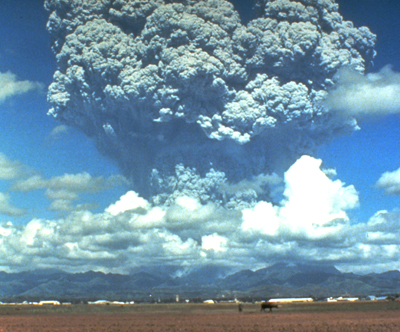
So, the idea is that we inject into the stratosphere the equivalent of a major Pinatubo-like eruption every so often, enough to offset the fraction of the warming resulting from increasing greenhouse gas concentrations.
Think About It!
Do you recall the answer from the problem set? Or if not, want to guess?
Click for answer.
In a relatively rosy scenario that we can keep atmospheric CO2 levels to no more than twice the pre-industrial levels, we would need an artificial Pinatubo-magnitude aerosol loading of the stratosphere every six years. For higher CO2 levels, we would have had to do this even more often. What sort of technology could we use to do this? Well, on the plus side, there is ready supply of sulfate aerosol available. The aerosols are a by-product of industrial activity, after all, the very cause of the tropospheric sulfate aerosol problem we have talked so much about before. Various schemes have been envisioned for transporting the aerosols to the stratosphere, involving either self-releasing containers of sulfate aerosols launched from the surface, or a direct release of the aerosols from jet planes flying in the lower stratosphere.

How sensible and safe is this idea? Is any approach that emulates what nature does already harmless? Or might it be "too much of a good thing" (to quote Shakespeare)? Some very respected scientists have advocated the approach, including Paul Crutzen, co-recipient of the 1995 Nobel Prize in chemistry for his work on stratospheric ozone depletion, and NCAR climate scientist Tom Wigley, among others. Their primary argument in favor of employing this approach is that we are unlikely to be able to effect the policy changes in time to avoid breaching DAI (dangerous anthropogenic interference with the climate system) through reduction of emissions alone (or CCS or Air Capture) and, therefore, may need a geoengineering scheme such as stratospheric sulfate aerosol injection to avoid dangerous climate change.
But there are certainly potential pitfalls. We will look at these in more detail later in the lesson. For one, the pattern of cooling, just like for a large volcanic eruption, is not uniform. Resulting changes in atmospheric circulation cause heterogeneous temperature changes, with some regions cooling significantly, and other regions potentially warming. For example, parts of the Arctic might actually warm rather than cool, which would exacerbate Arctic sea ice loss and perhaps the rate of melting of the Greenland ice sheet. These same changes in atmospheric circulation lead to shifts in precipitation patterns, such that many continental regions are likely to dry, meaning adverse impacts on water supply. Moreover, we know that sulfate aerosols can worsen stratospheric ozone depletion. Other approaches to solar radiation management might avoid some of these problems, but in general are either prohibitively expensive, e.g., placing reflecting solar mirrors in space, or require a scale of deployment that is not easily attainable, e.g., increasing the albedo of the Earth's surface by painting roofs and roads white, etc., or cloud seeding on a massive scale. Moreover, since the solar management approaches do nothing to stem the tide of increasing CO2 levels, they do nothing to mitigate the very serious threat of ocean acidification.
One selling point of solar radiation management schemes is that they can be deployed quickly, contrasting with the very slow, deliberate pace of greenhouse gas mitigation approaches. However, this speed might also be a pitfall. Were we to seek to offset substantial increases in greenhouse gas concentrations by such geoengineering schemes, we would become greatly reliant on their maintenance. In the event of war, economic collapse, sabotage, or any number of crises that might interfere with deployment schedules, there would be the very real danger of climate changes far more abrupt than would occur due to anthropogenic climate change alone; we could potentially unmask the previously hidden greenhouse warming due to decades of emissions in just a matter of years!
Oceanic Iron Fertilization
Finally, let us consider another intriguing, but also quite controversial geoengineering scheme: iron fertilization of the oceans. Like CCS and Air Capture, this scheme attempts to slow or reverse the buildup of CO2 in the atmosphere. Unlike those schemes, however, it accomplishes this in amending the natural carbon cycle.
Phytoplankton in the upper ocean play an important role in the marine carbon cycle, taking up CO2 from the atmosphere during the process of photosynthesis —this is the first step in what is known as the marine biological pump; the phytoplankton are consumed by other organisms, including those which form calcium carbonate skeletons. When those organisms produce waste or die, they transport their carbon into the deep ocean (by sinking to the bottom), providing a means of long-term carbon burial. Thus, in principle, one might be able to increase the burial of carbon in the ocean by increasing the productivity of phytoplankton.
In many regions, the primary limitation on phytoplankton productivity is the availability of key nutrients, and iron in particular. This can be seen during the natural phenomenon of phytoplankton "blooms". These natural explosions of phytoplankton activity are typically caused by a sudden increase in availability of nutrients, such as iron, nitrogen, and phosphorus, as a result of natural fluctuations in, e.g., oceanic upwelling. Since iron is the key limiting nutrient impacting phytoplankton productivity in many regions of the world oceans, such as the North Pacific and North Atlantic, adding iron to the upper ocean in those regions could, in principle, increase the burial of carbon in the ocean.
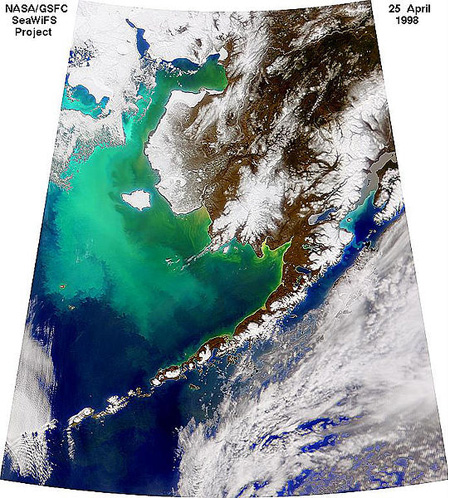
Once again, as fanciful as this scheme might sound, it is actually being done. A company called Planktos began initial efforts at ocean iron fertilization within the past decade, though the effort was cancelled due to lack of interest and funding.
So, does the idea actually have merit? The limited studies that have been done suggest that iron fertilization appears to increase phytoplankton activity. However, measurements of carbon fluxes suggest that the main effect is a faster cycling of carbon through the food chain of the upper ocean, with no impact on the ocean biological pump, i.e., no increase in the actual burial of carbon in the deep ocean. Thus, the effectiveness of iron fertilization in increasing long-term carbon burial remains very much in question.
Potentially even more troubling, however, is, once again, the very real possibility of negative unintended consequences. Some studies suggest that iron fertilization preferentially increases the productivity of toxic plankton, such as those responsible for red tides. Thus, this geoengineering approach could lead to potentially unpredictable, harmful effects on the marine ecosystem.
What Could Possibly Go Wrong?
We have already seen the answer to this question to some extent, but let us investigate the potential downside of geoengineering in a bit more detail.
Alan Robock is a leading climate scientist from Rutgers University. Over the past few years, he has been involved in some of the most innovative scientific work examining both the efficacy and potential pitfalls of geoengineering. You may also recognize him as the author of one of your assigned readings for this lesson, "20 reasons why geoengineering may be a bad idea" (published in the Bulletin of the Atomic Scientists).
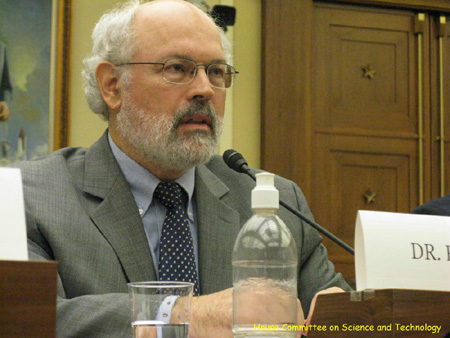
Robock primarily focuses on effects of the stratospheric sulphate aerosol solar modification scheme. The key pitfalls in the scheme are as follows.
Effects on regional climate
Stratospheric sulfate aerosol injection will not uniformly offset global warming, but will cool some regions while warming others. The same changes in atmospheric circulation responsible for this heterogeneous pattern of temperature change will lead to an overall drying of the continents.
Ozone Depletion.
Increasing stratospheric sulfate aerosols are likely to increase the rate of ozone-destroying reactions in the stratosphere.
Unintentional Warming
It is possible that sulfate aerosols distributed in the lower stratosphere could sink into the upper troposphere, where they might have the unintended impact of seeding cirrus clouds. As we saw earlier in the course, cirrus clouds may have a net warming influence on the surface, since their greenhouse radiative properties tend to outweigh their albedo impact in the net radiative forcing.
The following Robock's pitfalls apply more generally to other geoengineering schemes.
Lessened Availability of Solar Power
Any solar management scheme (sulfate aerosols, reflecting mirrors, cloud seeding) that involves a reduction in solar radiation received at the surface will mean reduced efficiency of solar power—a key renewable source of energy.
Danger of Rapid Climate Change
As discussed previously in the case of sulfate aerosol geoengineering, any of the solar management schemes suffer the danger that if they are discontinued suddenly for any reason (war, economic crises, human error, sabotage by other nations who view geoengineering as unfavorable to their climate), the greenhouse warming that had been "covered up" by the geoengineering scheme, would emerge suddenly, giving rise to sudden warming, and sudden alterations in wind and precipitation patterns that would be hugely disruptive to civilization and natural ecosystems.
No Going Back
To the extent that geoengineering is used as a crutch to allow continued carbon emissions that would otherwise lead to dangerous influence on the climate, we quickly become "addicted" to the fix of geoengineering. Because our commitment to sustained, long-term elevation of greenhouse gas concentrations becomes increasingly great, we cannot go back. A large fraction of the emitted CO2 will remain in the atmosphere for many centuries, and the only way to avoid realizing the warming impact of the higher CO2 levels is to faithfully continue with geoengineering for perpetuity. Indeed, as CO2 levels continue to rise further, the geoengineering "dose" must get stronger and stronger.
Continuing Ocean Acidification
Other than CCS and Air Capture, none of the geoengineering schemes deal with the threat of ocean acidification (while oceanic CO2 fertilization might stabilize atmospheric CO2, it could increase CO2 concentrations in the upper ocean, and thus might not prevent ocean acidification). We have seen that ocean acidification is one of the greatest environmental threats posed by increasing CO2—indeed, it is sometimes referred to as the "other CO2 problem". Any geoengineering solution that does not deal with this problem is, at best, a very incomplete solution.
Unintended Consequences
For every potential we come up with, there are probably several others we have not even thought of yet. Once you begin tampering with a system so complex as the Earth system, of which our understanding is very incomplete, and for which our theoretical models are still relatively crude, there is the potential for surprises. And it is unlikely that those surprises will weigh in our favor.
Summary
So, finally, where does this put us? If we conclude that the risks of geoengineering are not worth taking, what options does that leave us for mitigation? That is indeed the subject of our next, and final lesson of the course.
Lesson 11 Summary
In this lesson, we investigated the concept of geoengineering, and investigated various of the specific geoengineering schemes that have been proposed as potential approaches to mitigating climate change. We found that:
- Geoengineering schemes that have been proposed fall within one of two basic categories, either seeking to prevent CO2 from building up in the atmosphere, or offsetting greenhouse warming through schemes aimed at reducing the short wave, solar radiation received by Earth's surface.
- The least invasive scheme (so much so, that it is often not even considered geoengineering at all) is carbon capture and sequestration (CCS), aimed at capturing and burying CO2 at the point of emission. CCS is only useful, however, for large, concentrated emission sources such as coal-fired power plants. Moreover, it cannot lower CO2 ambient levels, but simply decrease the rate at which they are increasing.
- An alternative scheme, known as air capture, actively filters CO2 out of the atmosphere. It has the advantage of that it can be deployed widely (i.e., it isn't necessary to place it at or near the source of emissions), and because it acts on ambient CO2 levels, it could in principle be used to lower CO2 concentrations as well as stabilize them. It has the disadvantage of being far less efficient (and more expensive) than methods such as CCS which act on concentrated streams of CO2 emission.
- A number of other geoengineering schemes that fall under the category of solar radiation management instead attempt to decrease the incoming shortwave radiation by placing reflective sulfate aerosols, or reflecting mirrors, in the lower stratosphere, or by decreasing the albedo of Earth's surface.
- Stratospheric sulfate aerosol injection might be a relatively inexpensive option for offsetting greenhouse warming, but suffers a number of potential undesirable side-effects, including inhomogeneous temperature changes that could actually lead to even more warming in certain regions like the Arctic, possible decreases in continental precipitation, worsening of ozone depletion, and other potentially harmful chemical side-effects. Other schemes for radiation management avoid some of these complications, but are likely to be highly expensive or impractical.
- Another scheme known as oceanic iron fertilization seeks to stem the buildup of CO2 in the atmosphere by adding iron to regions where marine phytoplankton productivity is primarily limited by this nutrient, thus potentially speeding the uptake of atmospheric CO2 by the ocean. Initial experiments have shown no clear evidence however of increased deep ocean carbon burial, calling into question the efficacy of the scheme. Possible unintended consequences include increasing the competitive advantage of harmful plankton, such as those which cause red tides.
- In general, geoengineering schemes appear to be fraught with potential uncertainties, harmful known and perhaps unknown side effects. The law of unintended consequences would appear to apply to many, if not all schemes that have been proposed.
Reminder - Complete all of the lesson tasks!
You have finished Lesson 11. Double-check the list of requirements on the first page of this lesson to make sure you have completed all of the activities listed there before beginning the next lesson.
Introduction to Project #3
Suppose you had 3 minutes of your local congressperson's time to share with them your message about climate change. What would you tell them?
For this project you will put together a 2-3 minute multimedia presentation that can be made available to the class to view, discuss and critique.
Activity
What does Project #3 involve?
Your multimedia presentation should involve text, images, and narration of some sort, but it must include video. How you put this together, which application(s) you decide to use or what assortment of information, media, or images that you use is entirely up to you.
This project must follow the following guidelines:
- It must not exceed 3 minutes.
- It must include video (either yours or someone else's) somewhere in the presentation.
- It must include your own narration or explanation.
- All sources used that are not in the public domain should be cited as part of the presentation.
How should you get started?
PLAN
- Think about the central theme(s) of the message you want to convey. Ideally, it would include aspects of each of the three "phases" of the course (i.e., the basic science and projections, impacts, adaptation, and mitigation).
- Write this down in as clear and concise manner as possible. (Consider an intro, body, and conclusion approach for this.)
- Make a list of the evidence (text, images, video) that you will use to support your message.
STORYBOARD
- Sketch out a simple progression for organizing your presentation. This storyboard form [21] may help you organize the structure of your thoughts as you sketch things out.
- Include an introduction that will capture attention.
- Highlight the section where your central theme is presented.
- Add a concluding piece that reminds or summarizes your main point.
REQUIRED EQUIPMENT FOR CAPTURE
The equipment you will need depends on the application that you choose to build your presentation in.
Minimally, you will need a microphone to capture narration of your message. Most computers have microphones already installed. Headsets with microphones are inexpensive and are good for using with a number of different applications.
A video camera may be something else you may want to use. They come installed in a range of devices, including webcams and the movie mode on your digital camera or smartphone. Digital video recorders will provide the variety of options, whereas 'Flip' or phone cameras are very simple to use and the quality of the picture can be outstanding. However, if you are using a screen capture recording application, you will not need a video camera.
APPLICATIONS FOR BUILDING YOUR PRESENTATION
There are a number of applications that can be used to build your multimedia presentation. The application(s) that you use may depend on your experience and what software you have access to. There are a number of considerations you will need to entertain including:
- What equipment (cameras, microphones, etc.) will you need?
- What software do you have access to, and how difficult is the software to learn?
- How will my presentation be shared with others?
Below are some simple options for you to consider. You are not limited to using these applications. There has been an explosion of good, quick, cheap (or free) resources recently for capturing lectures or talks. Feel free to use any of these. The Quick Examples column on the right are links to simple examples intended to give you an idea of what each of these applications can do or additional resources:
| Resource | Learning Curve | Flexibility or Amount of Control | Notes | Quick Examples |
|---|---|---|---|---|
| Prezi
http://prezi.com/ [22] (link is external) |
Minimal - easy to grasp | Set themes that you modify | Web based application creates a zooming online presentation. You upload your media to your Prezi online. What you share: link to your online Prezi. |
How to create a great Prezi [23] (link is external) Eight Steps to Climate-friendly Work [24] (link is external) |
| VoiceThread
VoiceThread at Penn State [25] (link is external) |
Minimal - easy to grasp | Depends on the media you include | Create a VoiceThread using Penn State's version of this web based application. An interactive online 'conversation' based on the media that you upload and your commentary of this media. What you share: link to your online VoiceThread. |
What is VoiceThread [26] Global Warming [27] (requires a login) |
| Kaltura
Kaltura - Education [28] (link is external) |
Minimal - easy to grasp | Modification is up to the user | Penn State’s cloud-based media management platform for storing, publishing, and streaming videos, video collections, and other rich media such as audio recordings and images via your computer or mobile device. Kaltura can also embed quizzing functions within the media. | Penn State Media Commons - Kaltura [29] |
| Glogster | Minimal - easy to grasp | Set themes that you modify | Web based application creates an interactive online poster. You upload your media to Glogster online. What you share: link to your online Glogster. | |
| Microsoft PowerPoint + Zoom | Minimal - easy to grasp | Modification is up to the user | Create a slide show in Microsoft PowerPoint (available online with your Penn State Access ID). Create a Zoom meeting by going to psu.zoom.us [32] and hosting a meeting. Share your screen showing the slide show and record your voice-over with the slides. The resulting video can be uploaded to Kaltura or any number of video hosting sites (YouTube, Vimeo, etc.). | |
| Movie (Mac) or MovieMaker (PC) | Time consuming if you have no experience | Modification is up to the user | Normally available on the machine you purchased. If you have never used this software before, it will take time to learn about using the application as well as sharing your result. However, you can customize what your message looks like, just as a film editor would. What you share: Quicktime or Windows Media movie file. |
IMPLEMENT YOUR PLAN - PLEASE NOTE:
Multimedia production using any of these applications is not difficult to figure out. It can, however, be TIME CONSUMING!
Do not leave this project until the last minute. Technology will usually conspire against you! It is also difficult to provide support during the last hour. Plan your message out ahead of time. Explore and play with your equipment ahead of time in order to make sure that you do not minimally complete this assignment but, instead, use your media to get across a powerful message!
Use Free-to-Use images in your Presentation
Images are often protected by copyright. That means you cannot simply Google for images and use what you find. Instead, you must search for images that photographers have made openly available. You can find sources for such images below:
- Wikimedia [33]. Be sure to read the Reusing Content Outside Wikimedia [34] before reusing any images.
- Jamendo [35] - great place to find free-to-use music.
- Free Media Resources [36] - published and maintained as a part of the Media Commons initiative at Penn State.
- Flickr Creative Commons [37]. Images found in Flickr's creative commons gallery can literally be used for almost any project that is related to education, with nothing more than a credit to the original photographer. Be sure to read over the photographer's rules before reusing images and cite the license in your work.
Submitting your work
- Upload your file to YouTube or Vimeo and also post the link to your video in the Project #3 assignment in Canvas by the due date.
Grading Rubric
- The instructor will use the general grading rubric for the problem sets [38] to grade this project. (Downloadable PDF version [39])
Lesson 11 Discussion
Activity
Directions
Please participate in an online discussion of the material presented in Lesson 11: Geoengineering.
This discussion will take place in a threaded discussion forum in Canvas (see the Canvas Guides [40] for the specific information on how to use this tool) over approximately a week-long period of time. Since the class participants will be posting to the discussion forum at various points in time during the week, you will need to check the forum frequently in order to fully participate. You can also subscribe to the discussion and receive e-mail alerts each time there is a new post.
Please realize that a discussion is a group effort, and make sure to participate early in order to give your classmates enough time to respond to your posts.
Post your comments addressing some aspect of the material that is of interest to you and respond to other postings by asking for clarification, asking a follow-up question, expanding on what has already been said, etc. For each new topic you are posting, please try to start a new discussion thread with a descriptive title, in order to make the conversation easier to follow.
Suggested Topics
- What is the purpose of geoengineering? Why the anthropogenic climate change does not qualify as geoengineering?
- Discuss one of the geoengineering approaches that have been proposed to address climate change. What are the potential benefits of this scheme? What are the potential risk? In your opinion, do the benefits out-way the risks?
- Do you think geoengineering is a viable option for dealing with climate change? Do you see any ethical problems with continuing business-as-usual emissions and offsetting the warming consequences with geoengineering strategies?
Submitting your work
- Go to Canvas.
- Go to the Home tab.
- Click on the Lesson 11 discussion: Geoengineering.
- Post your comments and responses.
Grading criteria
You will be graded on the quality of your participation. See the online discussion grading rubric [41] for the specifics on how this assignment will be graded. Please note that you will not receive a passing grade on this assignment if you wait until the last day of the discussion to make your first post.
